How Many Types of Ants Are There?
Home » Blog » How Many Types of Ants Are There?
When you think of pests that can invade your home, ants are likely high on your list. These tiny, industrious creatures can sometimes be a nuisance, but there’s far more to them than their knack for getting into your sugar bowl. For pest control professionals and entomologists alike, a critical part of managing ant populations is understanding the sheer variety of ants that exist. Knowing how to identify different ant species can lead to more efficient and targeted control measures. So, how many types of ants are there? Let’s delve into the vast world of ants to find out.
The Importance of Ants in Ecosystems
Ants are among the most dominant insects on earth, thanks to their sheer number and remarkable adaptability. They play crucial roles in ecosystems, such as seed dispersal, soil aeration, and waste disposal. Certain ant species, such as leaf-cutters, are fantastic agriculturalists, while others, like weaver ants, are skilled architects. By maintaining a balance in nature, ants contribute to the well-being of many other species, making them an essential part of the global environment.
Ant Anatomy and Behavior
Understanding the anatomy and behavior of ants is fundamental in appreciating their ecological and evolutionary significance. Ants are eusocial insects, living in colonies, with each member having a specific role to play. Their bodies are divided into three distinct segments: the head, thorax, and abdomen. With three pairs of legs and a pair of antennae, they navigate and communicate through a well-developed system of pheromones and tactile signals.
For colonies to function efficiently, different castes of ants carry out specialized tasks. These castes are often physically distinct and have specific duties, from the queen, who is responsible for reproduction, to the sterile female workers, who forage for food and protect the colony.
Types of Ants
From the lush rainforests to the barren deserts, ants populate almost every terrestrial habitat. One estimate suggests that there are over 12,000 ant species worldwide, and new species are being discovered and described regularly. To simplify such a vast catalog of diversity, we can categorize ants into three main types, based on their prevalence and characteristics.
Common Ant Species
Certainly! Here are some common types of ants found in various parts of the world:
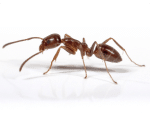
1. Argentine Ants (Linepithema humile):
- Native to South America, but now found worldwide
- Small, light to dark brown ants
- Form large colonies with multiple queens
- Considered invasive in many regions
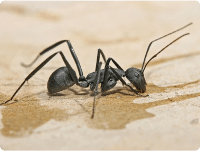
2. Carpenter Ants (Camponotus spp.):
- Found in forested areas worldwide
- Large ants, typically black or reddish-brown
- Nest in wood, often causing structural damage
- Important decomposers in ecosystems
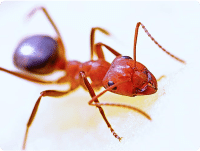
3. Fire Ants (Solenopsis spp.):
- Native to South America but have spread to many parts of the world
- Reddish-brown ants with a painful sting
- Build large, dome-shaped mounds
- Aggressive defenders of their nests
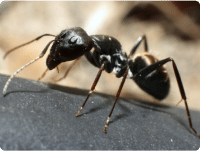
4. Pavement Ants (Tetramorium caespitum):
- Common in urban areas, particularly on sidewalks and pavements
- Small, dark brown to black ants
- Nest under pavement cracks or in soil
- Feed on a variety of foods, including sweets and proteins
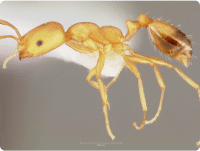
5. Pharaoh Ants (Monomorium pharaonis):
- Found worldwide, particularly in indoor environments
- Tiny, yellow ants with dark abdomens
- Nest in warm, humid areas, often inside buildings
- Known to spread pathogens and contaminate food
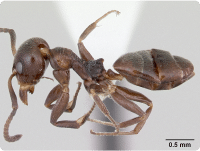
6. Odorous House Ants (Tapinoma sessile):
- Common in North America, but also found in other regions
- Small, dark brown to black ants
- Emit a strong, unpleasant odor when crushed
- Often enter homes in search of food, particularly sweets
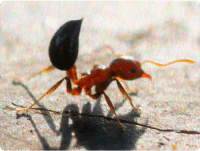
7. Acrobat Ants (Crematogaster spp.):
- Found worldwide, particularly in wooded areas
- Small to medium-sized ants, typically brown or black
- Nest in rotting wood or under stones
- Named for their habit of raising their abdomen over their head when disturbed
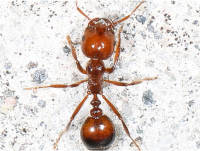
8. Red Imported Fire Ants (Solenopsis invicta):
- Native to South America, but invasive in many regions
- Reddish-brown ants with a painful sting
- Build large, dome-shaped mounds in open areas
- Considered a significant agricultural and ecological pest
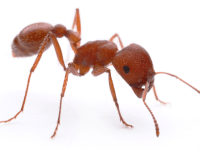
9. Harvester Ants (Pogonomyrmex spp.):
- Found in arid and semi-arid regions worldwide
- Large ants, typically reddish-brown or black
- Collect seeds as their primary food source
- Build large, conspicuous mounds in open habitats
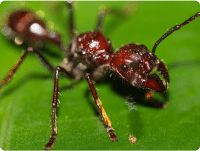
10. Bullet Ants (Paraponera clavata):
- Native to the rainforests of Central and South America
- Among the largest ants in the world
- Named for their extremely painful sting, which feels like being shot
- Important predators in their ecosystem
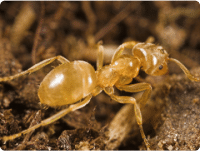
11. Crazy ants
- Crazy ants move rapidly and erratically, unlike ants that follow defined trails.
- Crazy ants are typically light brown to reddish-brown with slender bodies, long legs, and antennae.
- Crazy ants eat a variety of foods, including insects, honeydew, sweets, meats, and household scraps.
- Crazy ants nest in damp environments outdoors and indoors, like under rocks, logs, or in humid areas such as bathrooms and kitchens.
- Highly adaptable, crazy ants thrive in various environments, forming large colonies and outcompeting native species.
- Outside Africa, crazy ants spread rapidly, disrupting ecosystems and becoming significant pests.
- Crazy ants are attracted to electrical equipment, causing malfunctions by infesting wiring and electronic devices.
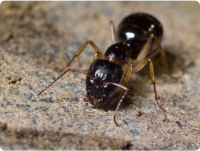
12. Worker ants
Worker ants are typically sterile females with smaller bodies than reproductive ants.
They possess strong mandibles for tasks such as foraging and nest maintenance.
Worker ants’ tasks within the colony depend on their age, with younger ants caring for the queen and brood, while older ants engage in foraging and defense.
Worker ants communicate primarily through chemical signals like pheromones.
They also use tactile and occasionally auditory cues for colony coordination.
Worker ants are highly adaptable to changing environmental conditions and colony needs.
These are just a few examples of the many types of ants found around the world. Each species has its own unique characteristics, behaviors, and ecological roles.
Lesser-Known Ant Varieties
While they might not be as infamous as common species, these ants have their own unique features and behaviors:
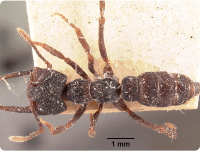
1. Dracula Ants
Members of this ant genus are known for their unusual feeding habits. They are social parasites, sneaking into other ant nests and feeding on the blood of their larvae, causing the host ant colony to dwindle.
Rare or Unique Ants
Some ant species are incredibly rare and have adaptations that are fascinating even to scientists:
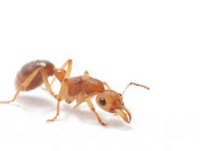
1. Nothomyrmecia
The Nothomyrmecia genus contains just one species, Nothomyrmecia macrops, native to Australia. It’s considered a living fossil, as the species is among the most primitive ants in the world and has changed very little over time.
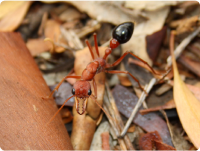
2. Bulldog Ants
These are the largest ants found in Australia, with a diverse range of species. Their powerful jaws and ability to leap make them formidable predators, and they are responsible for a significant portion of ant stings and bites in the country.
Understanding the vast diversity of ants, from the common pest varieties to the rare and unique, is crucial in both conserving their natural habitats and effectively controlling populations when they become problematic. For pest removal services, this underlines the importance of continual education and training in entomology to stay abreast of any new discoveries. This knowledge empowers professionals to address ant issues with the precision and care that our complex and varied ecosystems require. In conclusion, the number of species may seem daunting, but it is a reflection of the richness and intricacy of our natural world. Each new species discovered deepens our understanding and respects for the role ants play in maintaining a healthy planet. By learning about the many different types of ants, we can better appreciate their diversity and, in turn, take more effective measures to protect our homes and all the ecosystems that we share with these remarkable creatures.
Factors Affecting Ant Diversity
Ants, the tiny yet industrious creatures that inhabit almost every ecosystem on earth, are more diverse than one might think. Their intricate societies, ranging from colonies of only a few hundred to supercolonies that can span thousands of miles, contribute to their astonishing capability to adapt and prevail. This in-depth exploration seeks to uncover the staggering diversity of ant species, shedding light on their integral role in the greater ecological web, and serving as an informative guide for anyone dealing with these creatures at any level.
Factors Affecting Ant Diversity
What creates such a vast array of species? Numerous factors come into play, dictating the rise and fall of these resilient creatures. Let’s dive into the primary influences that have led to the rich tapestry of ant diversity witnessed worldwide.
- Climate and Habitat
- Competition with Other Species
- Human Impact on Ecosystems
Ants are masters of adaptation, and their evolution amidst varied landscapes and climates has unsurprisingly diversified their gene pool. From the tropical canopies, teeming with leaf-cutter ants meticulously tending to their fungal crops, to the desert-dwelling honeypot ants, with their ability to store water in their gaster, each species has honed unique traits to survive in its particular environment.
Furthermore, the sheer range of species is heavily influenced by the availability of niches within these diverse habitats. In resource-rich environments, competition spurs specialization, leading to the evolution of more ant species. Contrastingly, harsher habitats may result in fewer species, but often with particularly robust survival mechanisms.
Ants are by no means solitary creatures; they coexist in intricate webs of competition and cohabitation. Their incredible ability to form complex inter-specific relationships, such as herding aphids or protecting acacia trees, further contributes to their overall diversity.
Moreover, areas with high ant diversity typically have a high diversity of resources as well. Ants have filled every conceivable ecological role, from seed dispersers to predators, and as such, competition within and across species has led to the partitioning of resources, ultimately fostering greater biodiversity not only among ants but in the ecosystems as a whole.
As the dominant species on the planet, humans have a substantial impact on ant populations. Urbanization, monoculture, climate change, and pesticide use are just a few ways in which we influence the world of ants.
While some ant species have adapted astonishingly well to urban life, many are sensitive to the disturbances urbanization causes. Monoculture and the loss of native habitats significantly reduce ant diversity, and these changes in turn can lead to the proliferation of invasive species, further altering the natural balance.
How to Identify Different Types of Ants
Picture a quiet evening in your home, maybe reading a book or catching up on your favorite TV show, when you see them – a line of tiny, determined creatures marching across the floor, into the kitchen. Ants are a common sight, but did you know that not all ants are created equal? Understanding the diversity within the ant population can be the first step in managing an infestation. In this detailed exploration, we’ll take you through the intricacies of the ‘antscape’, helping you become an amateur entomologist in the process.
The Complex Universe of Ants
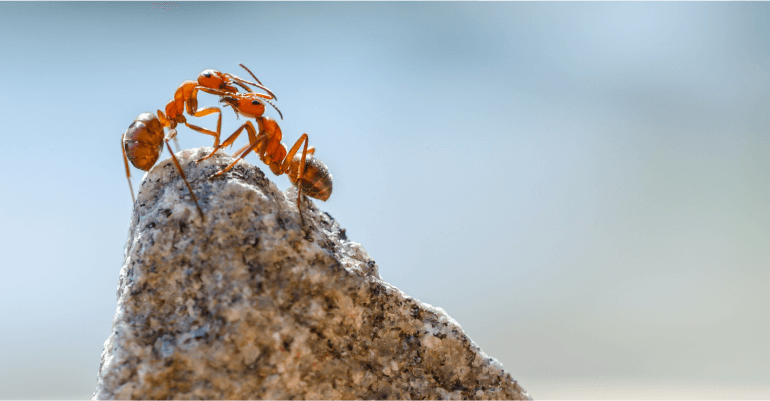
At first glance, ants might seem indistinguishable from one another, but on closer inspection, we find a complex ecosystem within each anthill. Ants can span from a few millimeters to more than an inch in size, and these variations in morphology can indicate the species. However, identifying specific types usually requires deeper knowledge.
Morphological Features: The Anatomy of Different Ants
The key to identifying ants lies not only in size but also in the number of body segments and their shape. Ants have three distinct body segments: head, thorax, and abdomen. The number of nodes on their petioles (the narrow ‘waist’ between thorax and abdomen) and the presence or absence of a stinger can be vital clues. For example, carpenter ants are rather large, with round thoraxes and a single petiole node, while acrobat ants have a heart-shaped abdomen with a distinct notch.
Genetic analysis
For the avid enthusiast or professional entomologist, genetic analysis is a game-changer. Thanks to DNA technology, we can now categorize ants with a high degree of precision, even when visual cues are sparse or when dealing with hybrid species. This is particularly useful when dealing with invasive species, which may be hybrids or highly adaptive genetically.
Behavioral traits
Beyond genetics and morphology, each species has its own behavioral patterns. The way ants forage, build their nests, and interact with their environment are distinctive traits that can help you tell them apart.
- Foraging and Nesting Habits
- Response to Environmental Stresses
Ants are nature’s most adept farmers, with some species cultivating their own fungus gardens or herding aphids. Fire ants, for instance, construct mounds in the ground and can form a painful, stinging defense line. Alternatively, pavement ants might build nests under concrete slabs, causing structural damage in the process.
Certain species are more resistant to environmental stresses, such as changing temperatures, humidity, or the presence of pesticides. Argentine ants, for instance, are particularly resilient and have become a global pest, displacing native species in many areas.
Common Key Types and Behaviors
Carpenter Ants: Masters of woodwork and architecture, these sizable ants excavate smooth tunnels through soft woods. Carpenter ants infestation often leading to structural damage in buildings.
Fire Ants: Aggressive and territorial, their painful stings can cause severe allergic reactions in some individuals.
Pharaoh Ants: Known for complex infestations within walls, cluster in pharaoh-like tomb structures, and are notoriously difficult to eradicate.
Argentine Ants: Form colossal supercolonies covering vast distances, making them a significant agricultural and domestic pest.
Understanding the distinctions in these behaviors is crucial, as it forms the basis for adopting species-specific control strategies.
Signs of an Ant Infestation
Ant infestations can be identified by various signs, which may include:
Visible Ants
Spotting ants indoors, particularly in large numbers or in multiple rooms, is a clear indication of a problem. Follow their trail to locate the entry point and any signs of nesting.
Ant Trails
Ants leave scent trails for their fellow workers to follow, which can often be seen as a line of ants traveling back and forth from a food source to their nest.
Entry Points
Ants can enter homes through tiny cracks and crevices, so closely inspecting potential entry points such as windows, doors, and foundation cracks is essential.
Nesting Sites
Depending on the species, ants may build their nests in walls, behind baseboards, under floors, or in wood damaged by moisture.
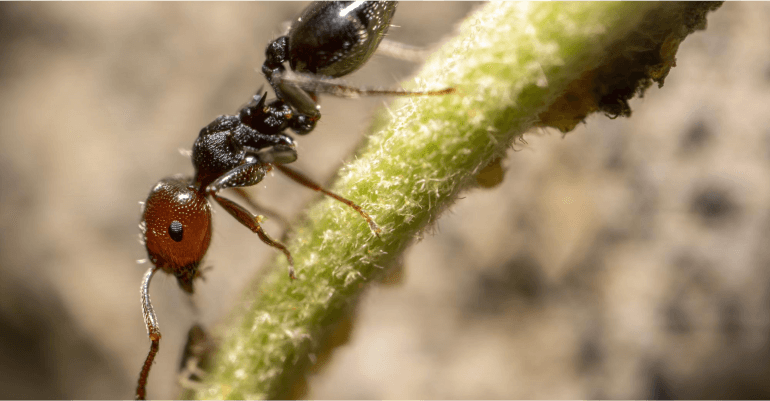
Prevention: The First Line of Defense
Preventing ant infestations before they occur is often more manageable than dealing with an established colony. Key preventive measures include:
Sealing Entry Points
Use caulk to seal cracks and openings where ants could enter your structure.
Keep Surfaces Clean
Ensure that all surfaces are free from spills and food crumbs, as these can attract ants in search of a meal.
Remove Standing Water
Ants need water as well as food, so keep sinks dry and fix any leaks promptly to prevent ants from being attracted to moisture sources.
Store Food Properly
Keep all food in tightly sealed containers, and never leave pet food out overnight.
Combating an Infestation
Addressing an existing ant infestation is a multi-step process that begins with identification and isolating the species involved. Ant control methods generally fall into one of three categories:
Natural and DIY Solutions
For minor infestations, non-toxic remedies can be effective. These may include using cinnamon or vinegar as a deterrent, maintaining a clean environment, and deploying DIY ant baits.
Chemical Treatments
For more serious infestations, professional-grade pesticides might be necessary. These treatments should be handled with care and are best managed by experienced professionals.
Structural Repairs
When ants are getting into a structure, it’s essential to identify and repair those entry points to prevent future re-infestations.
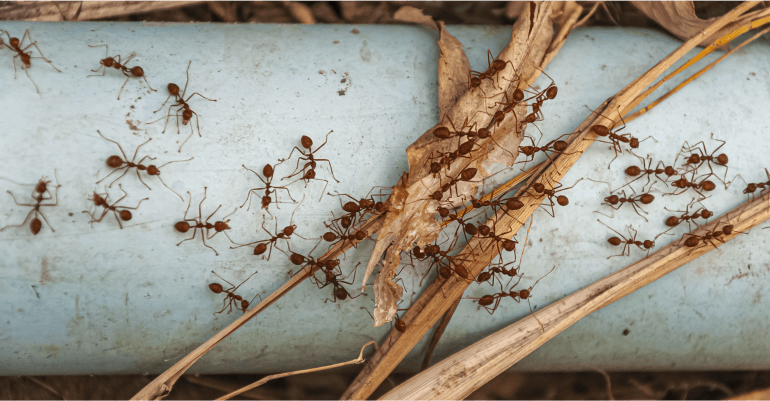
Partnering with the Professionals
Pest control companies play a crucial role in the management and eradication of ant infestations. They bring expertise, specialized tools, and access to higher-strength pesticides to bear on the problem.
Inspection and Identification
Technicians will thoroughly inspect the property to identify the ant species and the extent of the infestation.
Strategic Treatment Options
Based on the findings, a treatment plan is developed to target the ants’ specific behaviors and vulnerabilities.
Ongoing Monitoring and Prevention
Following treatment, regular monitoring and preventive measures are essential to ensure that the infestation doesn’t reoccur.



